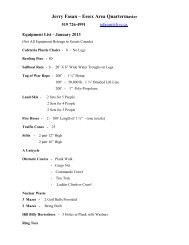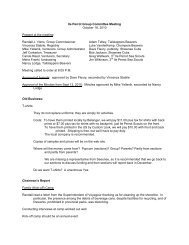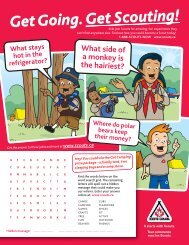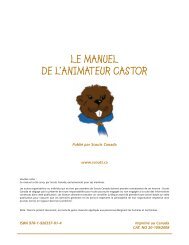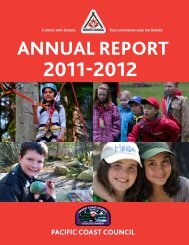Beaver Leader's Handbook - Scouts Canada
Beaver Leader's Handbook - Scouts Canada
Beaver Leader's Handbook - Scouts Canada
Create successful ePaper yourself
Turn your PDF publications into a flip-book with our unique Google optimized e-Paper software.
Where is your shadow? Is it longer than you are? Can you make shadow body letters? What<br />
other things make shadows?<br />
How tall is your leader? Can you trace the leader’s body with chalk while he or she lies on the<br />
parking lot? Can you trace other <strong>Beaver</strong>s’ bodies on the ground with chalk?<br />
Here are several keys to becoming a successful one minute naturalist.<br />
1. Try to consider commonplace things special. The <strong>Beaver</strong>s in your colony have only been on<br />
earth for 5-7 years. They have not yet experienced or closely examined things that are now<br />
routine to adults.<br />
2. Ask questions and seek simple answers. To a young child, nature is like a giant jigsaw<br />
puzzle. Every realization, from the recognition that pine cones make pine trees to the<br />
smell of rain, helps a child add another piece to a sometimes confusing world.<br />
3. Don’t try to give everything a name. Your aim is to stimulate recognition that something<br />
exists, and the desire to find an interesting quality in it.<br />
4. Use <strong>Beaver</strong>s’ discoveries to help build a theme or awareness of other meeting programs.<br />
This will carry forward any learning to other activities.<br />
5. Have fun and revel in a young child’s ability to see things we adults have forgotten even<br />
to look for.<br />
NATURE HIKES<br />
Here are some ideas you can build into a Saturday outing or even a short ramble in the vicinity<br />
of your pond on a regular meeting night.<br />
4 What do you smell?<br />
4 What do you hear?<br />
4 What type of ground do you walk on?<br />
4 What did you see on your way to your destination?<br />
4 Build a beaver dam, lodge, etc., with twigs and mud.<br />
4 Scavenger Hunt: Say the name of a plant or bird. Find something from nature that starts<br />
with each letter of the word (e.g. “daisy”: d-dirt, a-ant, i-insect, s-sand, y-yellow). For <strong>Beaver</strong>s<br />
who can’t read, draw pictures of things to find.<br />
4 Find something pretty.<br />
4 Find a tall tree.<br />
4 Find something that shouldn’t be there.<br />
4 Find something of a certain colour.<br />
4 Collect dead objects and make a list.<br />
4 What colours do you find in nature?<br />
4 Collect nature objects (e.g. grass, twigs). Close your eyes and feel different<br />
things.<br />
4 Snip an evergreen sample. Notice how it is different from the leaves of<br />
other trees.<br />
4 Give the <strong>Beaver</strong>s a leaf. Tell them to find one to match it.<br />
4 Study flower petals under a magnifying glass.<br />
4 Give <strong>Beaver</strong>s a film canister; how many things from nature they can put inside it?<br />
4 Show <strong>Beaver</strong>s an item from nature – make sure they are plentiful – then ask each to find a<br />
similar item, and return to the pond. Show another item, and send them off again.<br />
4 Find insects.<br />
15-7



